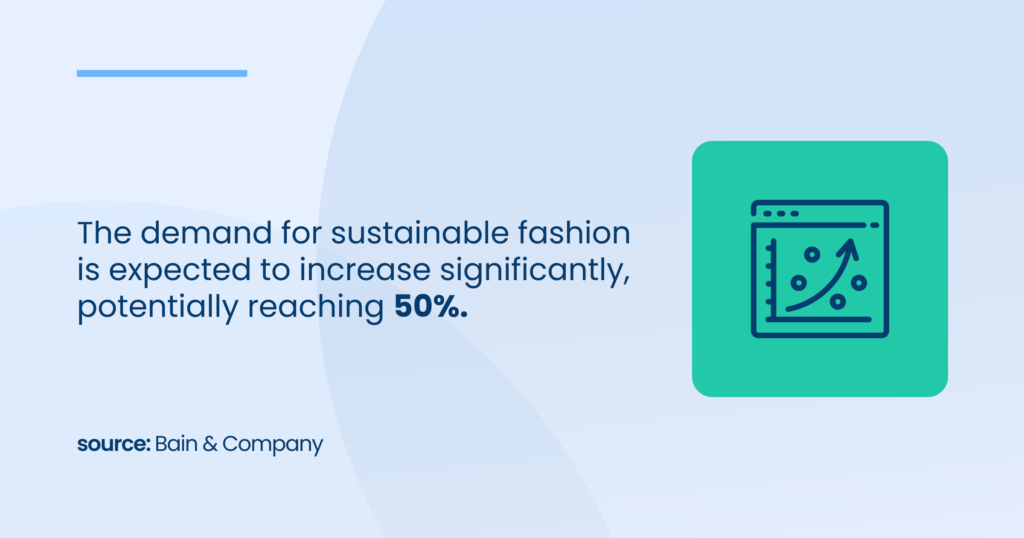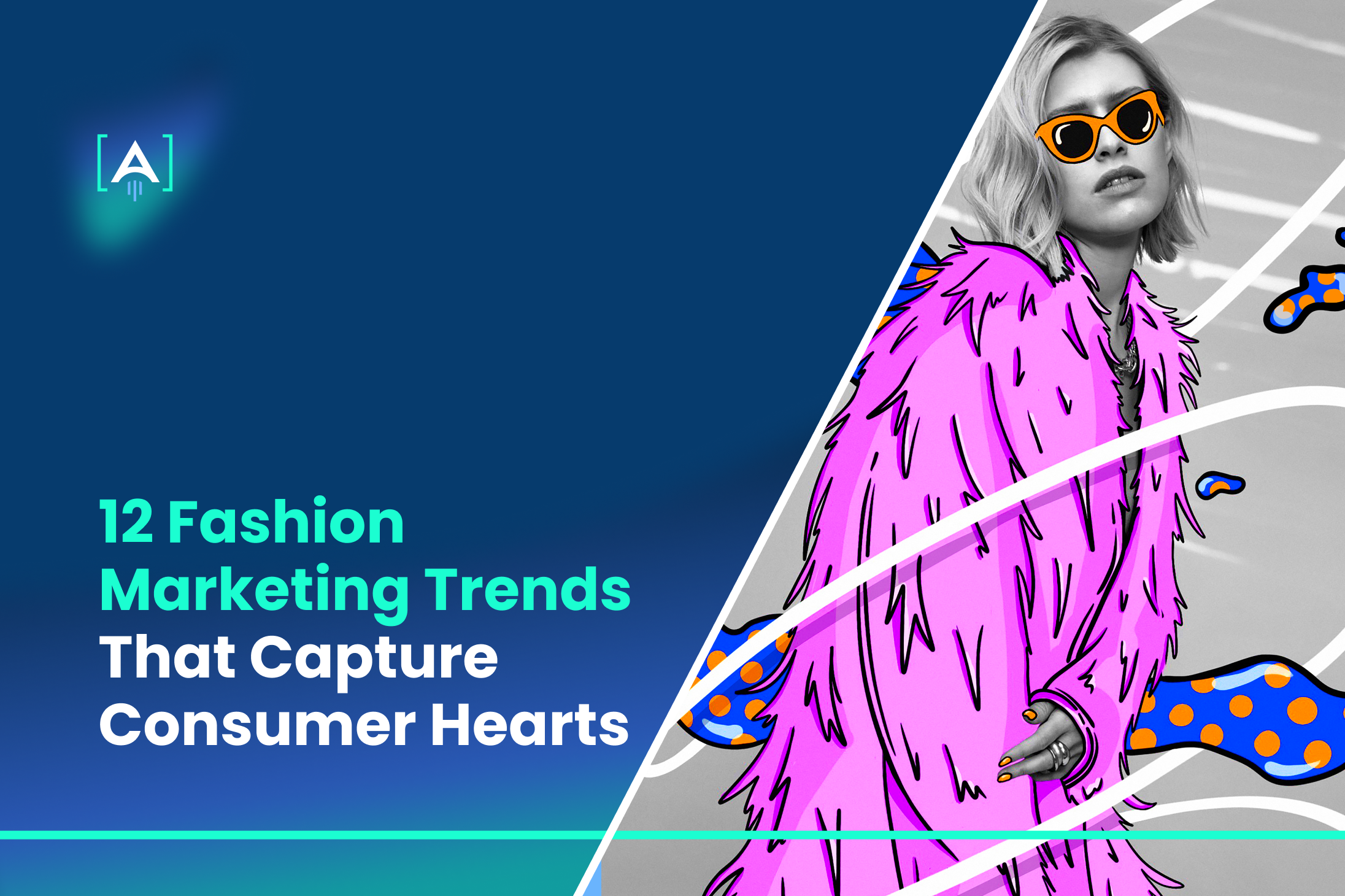The fashion industry is evolving rapidly, and staying ahead means keeping up with the latest fashion marketing trends. Consumer preferences are shifting toward personalization, sustainability, and immersive digital experiences.
Brands that embrace these trends can capture customer loyalty, strengthen engagement, and thrive in today’s competitive market.
Staying on top of fashion market trends is crucial for brands that want to remain competitive and meet evolving consumer expectations.
An expert fashion digital marketing agency can help brands connect with their audience, build stronger relationships, and drive growth.
In this article, we’ll discuss 12 e-commerce agency-approved fashion marketing trends that will help your brand capture consumer hearts beyond 2024.
1. Visual Storytelling: Bringing Fashion Marketing Trends to life
Visual storytelling conveys your brand’s message, values, and personality through powerful imagery and videos.
This form of marketing e-commerce goes beyond showcasing products—it’s about crafting a narrative that emotionally resonates with your audience.
Visual storytelling makes consumers feel a deeper connection to your brand by immersing them in your world, whether it’s luxury, sustainability, or casual everyday fashion.
A strong example of visual storytelling in fashion is Gucci’s “Gucci Aria” campaign. Celebrating its 100th anniversary, Gucci blended heritage with modern visuals through striking video and fashion films.
Source: Gucci
You can communicate your brand’s personality, values, and lifestyle through well-crafted visuals, a key element of today’s fashion marketing trends. This approach allows customers to experience the essence of your brand, making it more than just about the product.
Practical Tips for Business Owners:
- Show Your Brand’s Personality: Use behind-the-scenes videos or highlight the inspiration behind your collections. This gives customers insight into your creative process.
- Emotional Engagement: Focus on relatable moments where your products add value—whether boosting confidence or fitting into everyday life.
- Use Short-Form Video: Platforms like Instagram Reels, TikTok, and YouTube Shorts are perfect for quick, engaging content. Share product launches, styling tips, or design stories in 15-30-second clips.
- Make It Shareable: Create fun, authentic videos encouraging consumers to interact and share, boosting organic reach.
- Consistency Across Channels: Keep your visual style consistent across all platforms to reinforce your brand identity and message.
For business owners, visual storytelling is a powerful growth tool. It strengthens engagement, builds brand loyalty, and drives more conversions. Investing in compelling visuals makes your brand more relatable and memorable to consumers.
2. Hyper-Personalization: Tailoring the Shopping Experience
With technology shaping consumer behavior, fashion market trends now prioritize AI-driven personalization to enhance the shopping experience and boost engagement.
Using customer data, brands can create shopping experiences that match individual preferences. This keeps customers engaged and returning.
For example, ASOS recommends products based on browsing history and past purchases.
Source: Asos
AI enhances this by adjusting product displays and marketing messages in real-time. It personalizes emails, landing pages, and website content based on customer behavior, making interactions more relevant and boosting conversions.
How You Can Do It:
- Start Simple: Use customer data (like location or purchase history) to offer personalized recommendations or discounts.
- Leverage AI: Implement AI to tailor emails, dynamic web content, and product suggestions as customers shop.
- Refine and Improve: Continuously gather data and improve your personalization efforts to enhance customer loyalty and increase sales.
3. User-Generated Content (UGC): Building Authenticity and Trust
People trust what others say about your brand more than what you say.
Source: Taggbox
That is why user generated content UGC like product reviews, Outfit of the Day posts, and social media shoutouts is a powerful element of modern fashion marketing trends.
It’s real, raw, and relatable. When your customers share their favorite looks with your products, they buy and become brand advocates.
Encourage them to post their experiences, tag you, and share their love. This authentic content builds trust and makes your brand feel more approachable.
UGC also brings your community together. When one customer shares, others are inspired to follow. This creates a ripple effect that strengthens engagement and loyalty.
For example, Glossier has built an entire brand around this.
Source: Glossier Instagram
Their customers’ reviews, photos, and stories are at the heart of their marketing. It’s not just about selling—it’s about creating a community where people feel like they’re part of something bigger.
4. Sustainable Messaging of Fashion Marketing Trends
Consumers care about where clothes come from, how they are made, and if they align with their values. Sustainable fashion is a key trend, expected to grow significantly. Stay ahead with the latest fashion marketing trends.
The demand for sustainable fashion is expected to increase significantly, potentially reaching 50%.
Check Our Ultimate Growth Marketing Glossary

Source: Bain & Company
Brands that openly highlight ethical sourcing and fair labor practices gain a significant edge.
Everlane, for example, is known for its radical transparency. It breaks down the costs of its products and shares details about the factories it works with, giving customers insight into how and where their clothes are made.
Sustainability is no longer optional. Fashion brands need to communicate their eco-friendly efforts, whether they use recycled materials, reduce water usage, or minimize waste. Consumers want to support brands that take action.
Stella McCartney is a great example, having built an entire collection around sustainability, making it a central part of the brand’s identity and a key reason for its success.
Source: Stella McCartney
5. Inclusive Marketing: Celebrating Diversity and Representation
Fashion must represent everyone. Brands that embrace diversity and inclusion by featuring models of all sizes, ethnicities, and genders are following one of the key fashion marketing trends and can connect with a broader audience. The message is simple: fashion is for everyone.
Fenty Beauty is known for inclusive campaigns, which have transformed the beauty and fashion industry.
Source: Fenty Beauty
Inclusive marketing isn’t just about representation in ads—it’s about product offerings. Offering size-inclusive, adaptive clothing lines for different needs and body types ensures that no one is left out. Brands like Universal Standard have redefined what size inclusivity means in fashion.
6. Social Commerce: Seamless Shopping on Social Platforms
Social media has become a powerful shopping platform. Instagram, TikTok, and Pinterest now offer seamless shopping experiences. Social commerce brands sell directly through these platforms, meeting customers who already spend their time.
The friction between browsing and buying is gone. With Instagram’s “Shop” feature, users can discover and buy products without leaving the app.
Live shopping events are gaining popularity, especially with younger audiences via mobile commerce. Brands can engage viewers with live-streamed product demonstrations, limited-time offers, and Q&A sessions.
It’s an interactive and immediate way to drive sales. Nike has successfully used live shopping on social platforms to sell limited-edition products.
Personalized Shopping Experience Playbook
7. Augmented Reality (AR) and Virtual Try-Ons: Enhancing the Digital Experience
Augmented reality is transforming the online shopping experience. With AR, customers can virtually try on clothes and accessories, eliminating the guesswork and reducing return rates.
Brands like Gucci and Warby Parker offer AR try-on features that let customers see how products look before purchasing.
Source: Retail Dive
Virtual fashion shows allow brands to engage a global audience in real time. Consumers can watch runway shows, browse collections, and make purchases directly.
This immersive experience blends fashion with technology and connects with a tech-savvy audience.
8. Subscription Models: Creating Long-Term Customer Loyalty
Subscription services have gained popularity as a way to deliver curated fashion experiences. Brands like Stitch Fix personalize clothing selections based on customer preferences. This ongoing engagement keeps customers invested in your brand while providing a convenient and tailored shopping experience.
Offering exclusive perks to subscribers, such as early access to new collections or members-only discounts, makes this process an excellent customer retention strategy.
Subscription models foster a deeper connection between the brand and its customers, turning one-time shoppers into long-term loyalists.
9. Data-Driven Marketing: Optimizing Campaigns with Insights
Data is the backbone of modern marketing. Brands that use data analytics can refine their marketing strategies, improve targeting, and create campaigns that resonate with specific customer segments.
For instance, H&M uses data-driven insights to optimize inventory and personalize the shopping experience.
AI can predict fashion trends and customer behavior based on past data. This helps brands anticipate market demands and create timely campaigns.
By tapping into predictive ecommerce analytics, brands stay one step ahead of consumer desires, ensuring they offer what’s in demand before competitors.
10. Omnichannel Strategies: Bridging Online and Offline Retail
An omnichannel strategy integrates both online and offline experiences, ensuring a cohesive brand experience, and is one of the important fashion marketing trends for modern retailers. Whether a customer shops on your website, app, or in store, the experience should be seamless.
Brands like Zara use Click-and-Collect services to allow customers to purchase online and pick up in-store, enhancing the shopping journey.
In-store technology like QR codes, mobile checkout, and AR mirrors enrich the customer experience. This digital integration bridges the gap between online browsing and physical shopping, making the entire process smoother and more enjoyable for consumers.
11. Interactive Content: Boosting Engagement and Conversion
Interactive content such as quizzes, lookbooks, and contests encourage users to engage with your brand in fun, personalized ways. This boosts engagement and creates memorable experiences.
Here are the 7 types of interactive content marketers find effective worldwide:
Source: Statista
Brands can use AR filters on social platforms to allow consumers to interact with their products. These filters are fun, engaging, and offer a unique way for consumers to see how they might look in your latest collection. This technology keeps your brand fresh and innovative.
12. Experiential Marketing: Creating Memorable Brand Experiences
Experiential marketing offers customers an interactive, memorable experience that deepens their connection with your brand and is one of the innovative fashion marketing trends driving engagement today. In fashion, this can include pop-up events, in store activations, or unique workshops that let customers engage with your products beyond just browsing.
Example: Levi’s Tailor Shops allow customers to personalize their jeans with patches, embroidery, and alterations in-store.
This hands-on experience allows shoppers to create something unique, making the brand experience fun and personal. It also strengthens Levi’s message of individuality and self-expression.
How You Can Do It:
- Host In-Store Customization: Allow customers to personalize or alter their items, making their purchases more meaningful.
- Create Interactive Pop-Ups: Set up temporary pop-up events where customers can engage with your brand in a fun, creative way.
- Offer Workshops: Teach customers something new, like how to style outfits or care for specific fabrics, creating a more interactive shopping experience.
Evolve, Adapt, Succeed: Partner with a Fashion Marketing Agency
Fashion is ever-changing, and the brands that stay ahead of these 12 key e-commerce marketing and fashion marketing trends will capture consumer hearts in 2024.
Whether it’s harnessing the power of AI, investing in sustainable practices, or creating immersive AR experiences, now is the time to evolve your marketing strategy.
Adopting these trends can help your brand grow, build trust, and foster lasting relationships with your audience. Start implementing them today and ensure your brand thrives in a rapidly evolving market.
Partnering with a fashion digital marketing agency gives you access to e-commerce marketing services, set up e-commerce ads, and apply the latest strategies, tools, and insights to help your brand thrive.
At [A] Growth Agency, we specialize in e-commerce seo, e commerce advertising, email marketing, social media management, content creation, paid advertising, and data analytics—all tailored to the unique needs of fashion brands.
Our data-driven approach ensures your brand reaches the right audience, builds trust, and drives long-term growth.
Ready to elevate your fashion brand?
Get a free marketing plan, and let’s unlock your brand’s full potential in 2024 and beyond!

